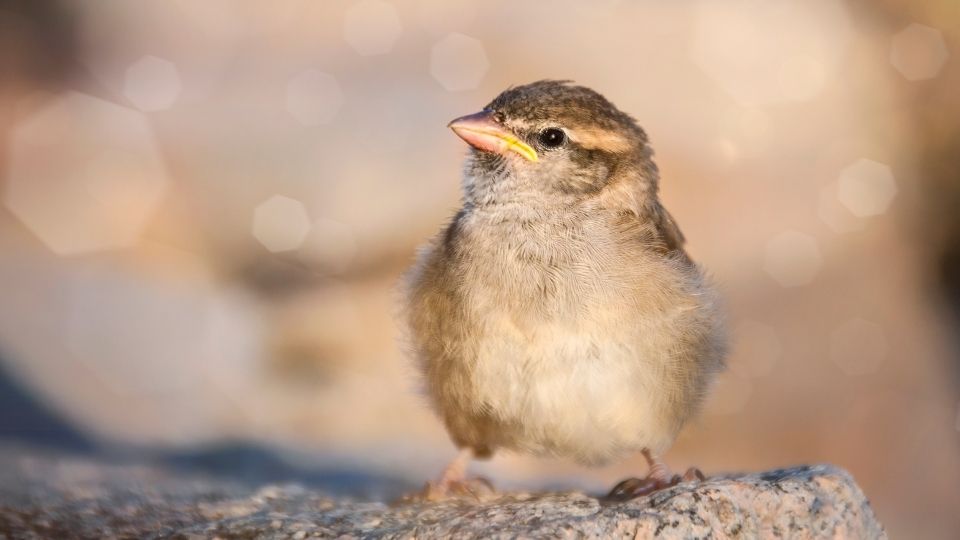During the Spring and Summer, it’s common to see sparrows busily building nests and tending to their young. Sparrow pairs are faithful to each other and their nesting location, so the sparrows you see year after year are likely the same pair.
Sparrows lay two to three clutches of eggs a year, but a fourth round of eggs is not uncommon. They are attentive parents, with both parents taking on the responsibility of feeding baby sparrows until they are ready to be on their own.
Unfortunately, raising nestlings doesn’t always go as planned, and sometimes baby sparrows end up in trouble. So, how can you tell if a baby sparrow is in need of human intervention, and if so, how do you raise a baby sparrow to ensure it has the best start possible when the parents aren’t there?
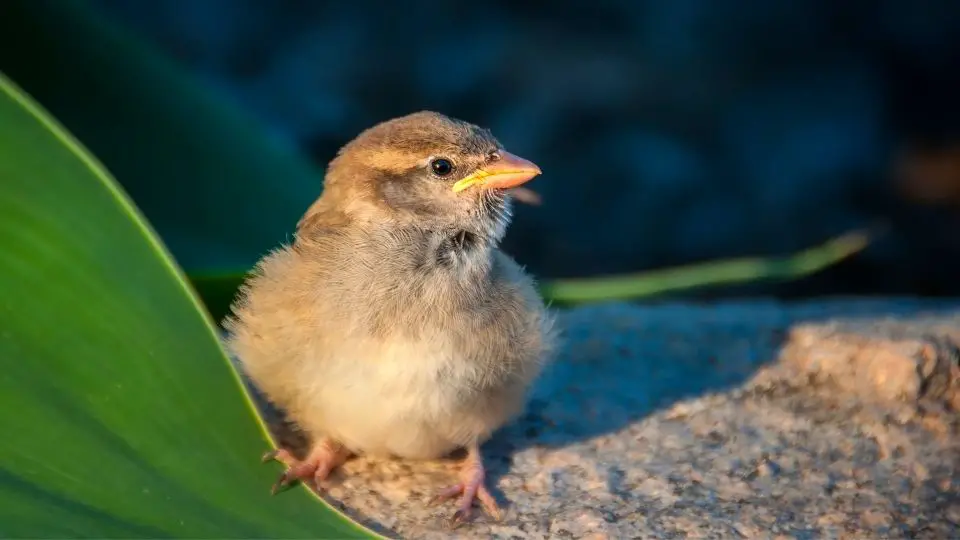
What to do if you found a baby Sparrow?
If you find a baby sparrow in your yard, the best thing to do is leave it alone. Fledgling house sparrows leave the nest 14-17 days after hatching and remain on the ground until they learn to fly. If the baby sparrow you found has feathers, it should only be removed if it is in immediate danger from predators.
At this stage of a baby sparrow’s life, the male sparrow tends to them on the ground while the female sparrow readies herself for the next clutch. Unless the adult sparrow doesn’t return for more than an hour, this baby bird is learning to navigate the new world, and they should be left alone.
A nestling baby sparrow is featherless and has its eyes closed. At under two weeks old, this baby bird is much too young to be out of the nest. It may have fallen from the nest accidentally or been shaken loose by high winds. No matter how the baby sparrow ended up on the ground, it cannot safely stay there.
In this scenario, the best thing to do is to locate the nest and place the baby bird safely with its siblings. Sparrows like to build their nest in tight spaces like holes and crevices in buildings. Free-standing nests may also be built, so check any thick hedges or trees near where you found the baby sparrow.
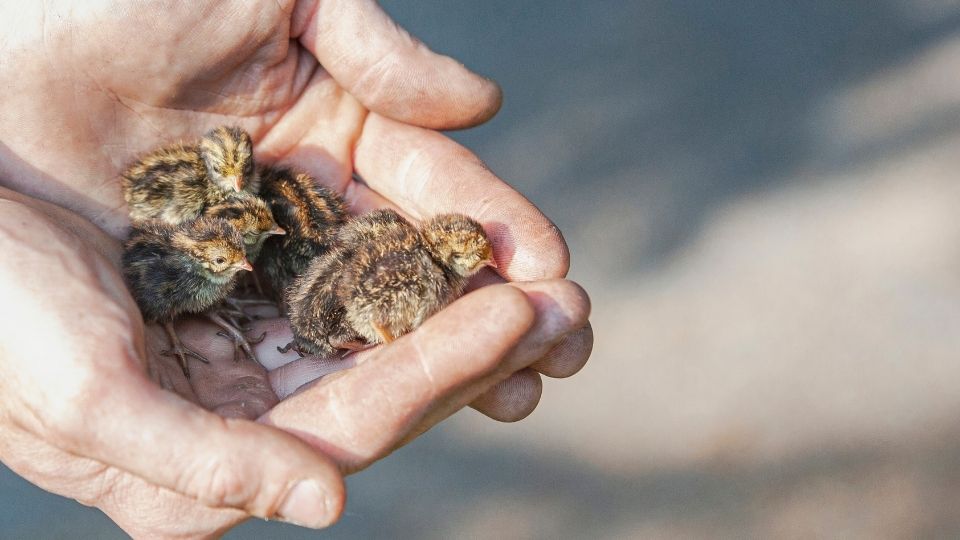
Place it back in the nest as gently as possible. Each clutch is two to five eggs, so if you don’t see other babies in the nest, it’s a good idea to check the area for other babies. It is a myth that human scent causes animals to reject their young, so you can rest assured a baby sparrow returned to the nest will be cared for by its parents.
Building a shelter for a baby Sparrow
If you can’t locate the baby sparrow’s nest or the original nest is destroyed, another option is to make a temporary nest.
Building a nest box will protect the bird from predators such as blackbirds and local cats.
Building a temporary nest also makes it easier for the mother bird to locate their young and continue to care for them.
To build a shelter for a baby bird, you need to think like a bird.
Use a basket with plenty of drainage (a berry container works great) and line the temporary nest with soft grass, twigs, and leaves. Sparrows also use feathers to line their nests and have been known even to pluck feathers from live pigeons. If you’ve ever found a discarded nest, you know that birds will use almost anything they find to line their nests. Just be sure to avoid hair as it can wrap around toes, legs, and beaks, causing severe damage.
Once you’ve finished, place the baby bird inside the nest, and hoist it on a line off of the ground to a safe location. If possible, position the nest, so it is tight against a wall or tree and not swinging wildly in the wind.
The key is to place it as close to the original nest as possible so the mother can locate the baby bird.
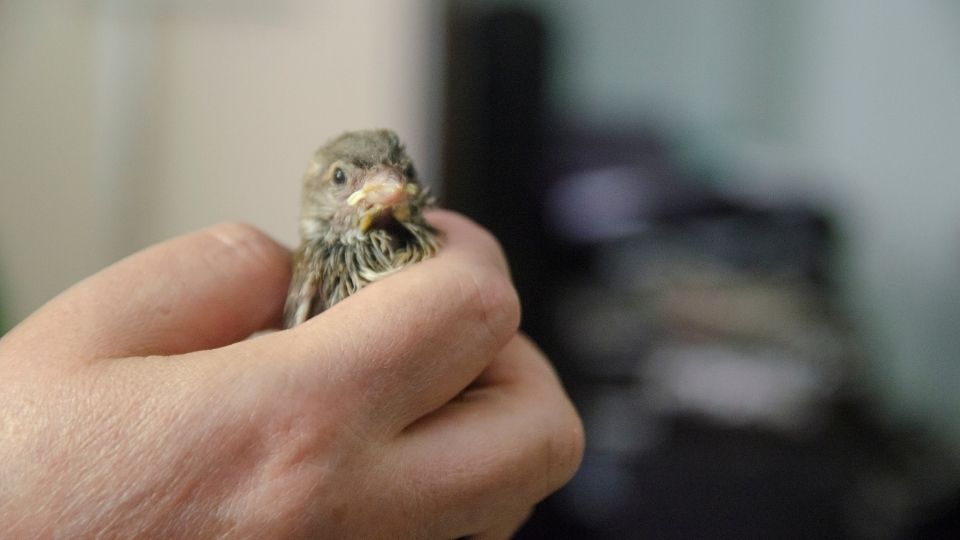
Is it okay to keep a wild bird like a Sparrow?
With many birds, it’s considered illegal to keep a wild bird as a pet. Most songbirds are covered under the Federal Migratory Bird Treaty Act and are only allowed to be kept by federally permitted rehabbers. However, since there are so many house sparrows found worldwide, it’s not against the law to care for a baby sparrow yourself.
Keep in mind that baby birds require a lot of care. It’s also vital to ensure the baby sparrow is not injured in any way. If the young bird has visible injuries or has been in the mouth of a cat or dog, reaching out to a permitted rehabber is your best bet.
If the baby sparrow is free from injuries and you’re prepared to care for it, here are the things you need to know to raise an orphaned wild bird successfully.
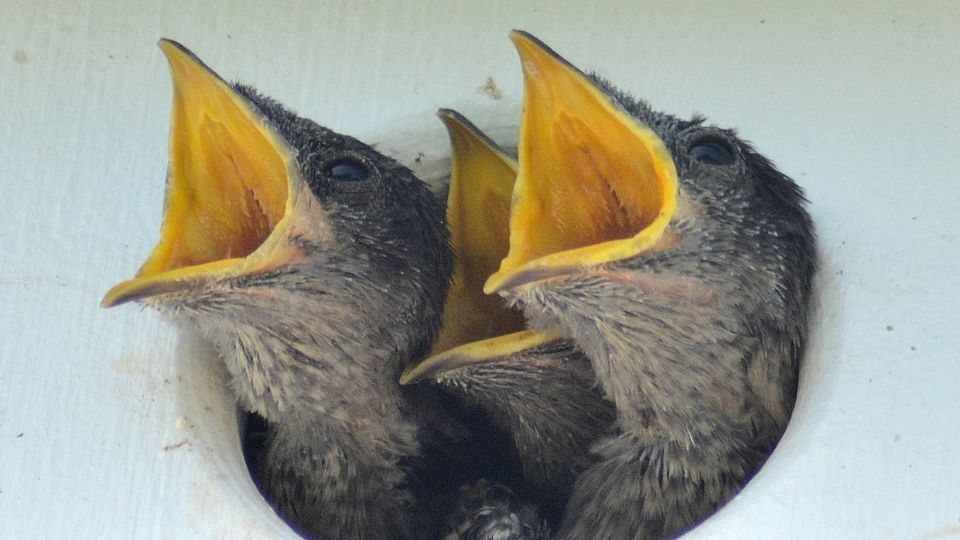
Housing a baby Sparrow
Once you’ve determined that human intervention is needed, your baby sparrow will need a place to live. Ideally, once the young bird is out of danger and able to care for itself, it should be released to live out its life with its flock. Wild birds thrive on social interaction, so it’s very important to provide adequate care without limiting the young bird.
Do your best to feed and care for the bird with as little human interaction as possible. You can create a quiet baby bird house with items you already have on hand.
The ideal temperature for your baby sparrow is 85-90° F
Set a heating pad on the lowest setting and place it in a tissue box or another small box with plenty of holes cut for ventilation is ideal. Make sure you put several tissues or paper towels between the heating pad and the baby sparrow.
If you don’t have a heating pad readily available, a flat bottle filled with hot water under the box or an overhead lamp directed at the box will work in a pinch. Check the temperature inside the box often and adjust as needed.
Do not use terry cloth towels or any fabric with looped fiber as the claws or beak may be damaged.
Keep the box in a quiet and dim place away from pets and children. Baby birds sleep when they’re not eating, so warmth and quiet are essential.
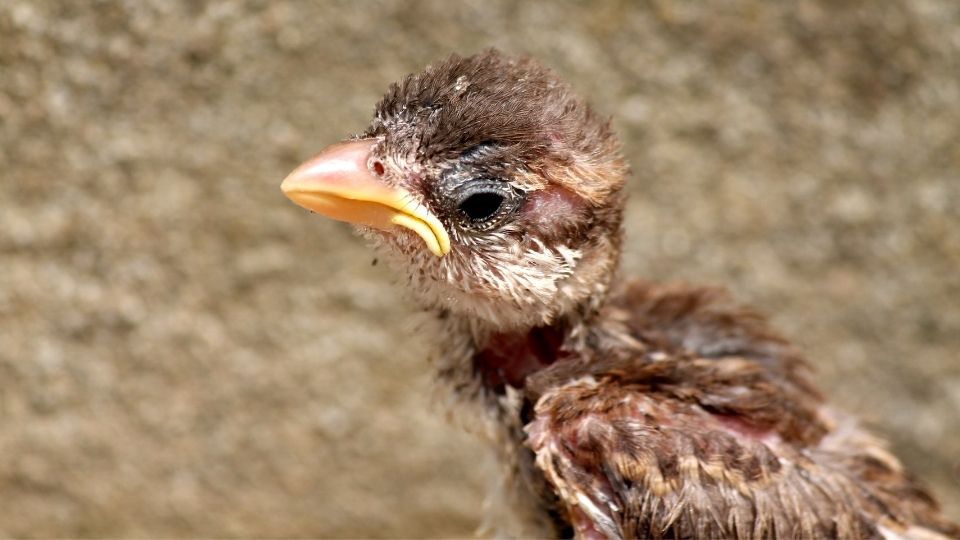
What should you feed a baby Sparrow?
What you feed your sparrow chick will depend on the age. A nestling should be fed soaked cat food or dog food. Puppy or kitten formulas are ideal since they have a higher protein diet that closely mimics baby sparrows’ needs.
Baby sparrows also need calcium, so mix a bit of baby bird formula or a pinch of powdered calcium supplement in the water before soaking the kibble. Powdered calcium for birds or reptiles can be purchased at most pet stores.
Soak the kibble in the water mixture, then use a pair of tweezers to offer small pieces to the nestling, no more than half the width of your pinky fingernail. Nestlings need to be fed every 20 minutes during daylight hours. When they are full, they will stop eating. If your baby sparrow is still gaping and wiggling its wings, it is still hungry.
Once your little sparrow opens its eyes and grows feathers, you can ease in to feeding every two hours. Your fledgling sparrow will flap its wings and vocalize when it is hungry.
Continue to feed soaked kibble, but fledgling sparrows are also ready for some variety in their diet. You can add a little bit of wild bird seed to their kibble. Now that your sparrow chick is older, you can offer small amounts of mashed, soaked kibble in a shallow dish.
You may also offer tiny amounts of water at this age, but only from a spoon or a songbird sipper bottle. Young birds are clumsy and prone to accidental drowning, even from a shallow container. Any water offered should be immediately removed when you are not supervising the baby sparrow.
House sparrows need plenty of bugs, which you can feed live via tweezers, or mash into their wet kibble food. You can source your insect diet from outside if you don’t spray insecticides in your yard.
Small invertebrates, spiders, snails, slugs, aphids, caterpillars, mealworms, and small crickets are good sources of nutrition for your young bird. Dried mealworms for chickens or reptiles are also a nutritious option.
While wild sparrows sometimes eat earthworms, many vets caution there is something toxic about earthworms to captive birds–even wild caught ones. It’s better to avoid them and stick to the options above for your young bird.
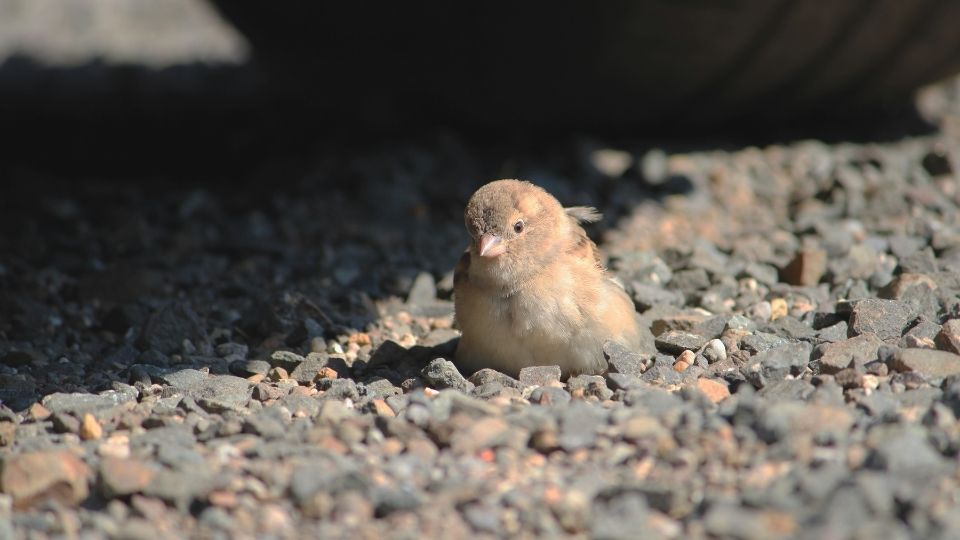
How do I know when to release my baby Sparrow?
Congratulations! You’ve successfully reared an orphaned sparrow and now you’re ready for the next step. After spending so much time with your baby sparrow, releasing them is bittersweet. But don’t worry, like everything else, releasing them takes time and lots of patience.
A baby sparrow is ready to be on its own at about three to four weeks of age. Once they start flapping their wings and hopping around their box, they are ready to spend time outside between feedings. A bird cage is a great way to reintroduce them to the wild gradually.
Start by putting the cage outside with the door closed. Make sure there is shade and ample sun. Your neighborhood sparrows will be drawn to the young bird, singing to it and gathering around. This may take several days.
Once you notice sparrows gathering around the baby sparrow, you can leave the door open. When the baby sparrow is ready, it will fly away and join its flock.
Since sparrows tend to stay in the same area, you can rest assured you’ll be seeing the baby sparrow for years to come.
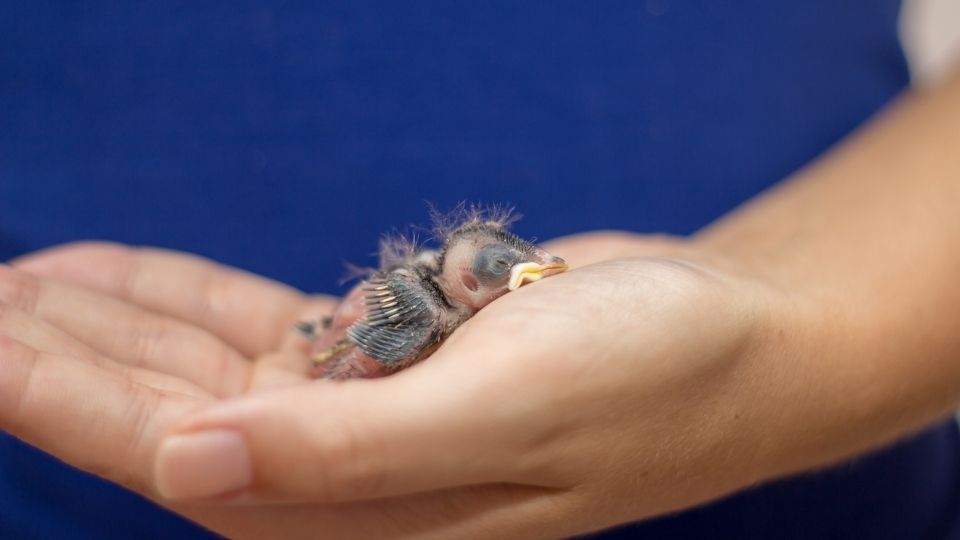
Common Mistakes
Taking care of a baby bird is a big responsibility, so make sure that you are up to the challenge!
One of the biggest mistakes of bird caretakers is not ensuring that your bird is warm enough.
Sparrow nestlings cannot regulate their body temperature.
When caring for your bird, make sure that you use a heating pad to keep it ideally at 85-90° F.
Also, make sure that you cut their food into small, manageable pieces that are easier to digest.
Insects can cause impaction and constipation in hatchlings, so ensure you don’t add insects until your baby sparrow has feathers and opens its eyes.
Handfeeding them is difficult, so using tweezers makes it easier to handle small portions of food.
Baby sparrows get their hydration from food. Do not offer water to hatchlings as they may aspirate or drown.
Only offer fledglings water from a spoon or bird waterer with a shallow opening while supervising.
Remove water and uneaten food immediately to prevent drowning or defecating in food.
Know when to call in the experts if your baby bird seems sick or injured.
Bird rehabbers can help your baby house sparrow grow up strong and can help it recover from sickness or injury.

